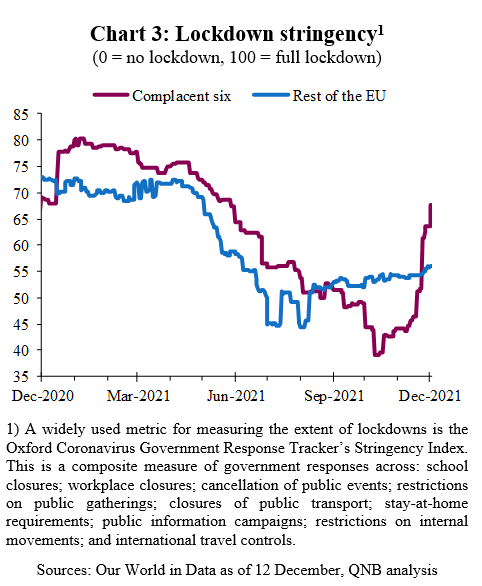Last winter, European governments faced a surge in new cases of COVID-19 driven by more infectious variants and by cold weather keeping people indoors. The only tools at hand to manage the situation at that time were strict lockdowns and social distancing measures.
However, banning social gatherings during the festive holiday season was not a popular move, so governments are keen to avoid a repeat of strict lockdowns this winter. Fortunately, with the authorization of effective vaccines, governments now have a powerful tool to control the pandemic.
After a slow start, European Union (EU) countries engaged in vaccination programs at their fastest rate around the second quarter of 2021. This helped new cases of COVID-19 infection to fall to an extremely low level in June this year. It also allowed EU countries to begin to relax restrictions, helped by warmer summer weather.

Sources: Our World in Data as of 12 December, QNB analysis
Unfortunately, the number of infections has surged since the end of September. Northern European countries have seen the largest increase, led by: Austria, Belgium, Germany, Ireland, the Netherlands, and Poland. This week, we show how complacency regarding vaccinations and lockdown stringency help explain why the “Complacent six” countries are experiencing a worse surge in infections than the rest of the EU (Chart 1 above).
First, despite more rapid initial progress, the vaccination rate in the “Complacent six” slowed sharply at the beginning of September and by more than the rest of the EU (chart below). While the EU’s public health agency recommended to accelerate the rollout of third “booster” doses, the speed of the rollout in the “Complacent six” has been slower than in the rest of the EU.
Furthermore, more children in the rest of the EU have been vaccinated than in the “Complacent six.” For example, most children in Denmark and Spain have been vaccinated with at least a single dose while Germany lags behind. Some time ago, governments in Italy and France made vaccination compulsory for specific groups of workers, but the “Complacent six” have only recently made similar moves.

Sources: Our World in Data as of 12 December, QNB analysis
This complacency and hesitancy regarding getting unvaccinated people their first dose, convincing people to take a second dose, authorizing third “booster” doses for the most vulnerable as well as vaccinating children have left the “Complacent six” more vulnerable to the surge in new cases this winter.
Second, we also see a notable difference in the stringency of lockdowns since the end of August, with the “Complacent six” relaxing restrictions further, despite the risk of a winter surge, while the rest of the EU actually tightened restrictions (see chart below).
For example, between September and early November, Austria relaxed most of its lockdown measures to support its economic recovery and Belgium also rapidly removed its restrictive measures. This loosening of restrictions, combined with resistance towards vaccinations within their populations, helps to explain the more severe surge this winter in the “Complacent six.”

Sources: Our World in Data as of 12 December, QNB analysis
A widely used metric for measuring the extent of lockdowns is the Oxford Coronavirus Government Response Tracker’s Stringency Index. This is a composite measure of government responses across school closures, workplace closures, cancellation of public events, restrictions on public gatherings, closures of public transport, stay-at-home requirements, public information campaigns, restrictions on internal movements, and international travel controls.
Due to the surge in COVID-19 cases, governments in the “Complacent six” were forced to tighten restrictions sharply (chart 3). Austria went into a national lockdown on Nov. 22 and is making vaccination mandatory from Feb. 1 2022. Germany has moved to restricted access to non-essential services (including theatres, cinemas and restaurants) to vaccinated customers only.
Belgium and the Netherlands also introduced partial lockdowns. Even Poland has tightened restrictions by re-introducing capacity limits on non-essential services. Tighter restrictions have been able to contain the surge, so countries now have more room to maneuver and are able to focus on imposing only the most effective restrictions.
The tighter restrictions will directly impact economic activity during the next few months. The impact will be largest on the services sector in the “Complacent six” countries as visits to recreation and cultural venues will be severely limited during restrictions and lockdowns. However, the impact may spill over to the rest of the EU, as these economies are so closely interconnected and integrated.
We therefore expect economic growth in the EU to be weaker than the 5.1% forecast by the International Monetary Fund in their October World Economic Outlook. We also expect there to be a similar pattern in North America with US states that have the lowest levels of vaccination and loosest restrictions also seeing a surge in COVID-19 infections that eventually will force them to tighten restrictions.
